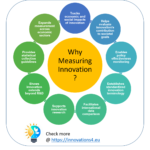The Oslo Manual provides a framework for measuring innovation, enabling the understanding of its impact on economic and social changes.

This should inform policy decisions to drive growth and improvement.
All the reasons for measuring innovation
The Oslo Manual provides several important reasons for measuring innovation according to its framework:
- To better understand economic and social changes: Innovation is central to improvements in living standards and can affect individuals, institutions, economic sectors, and countries in multiple ways. Measuring innovation helps track these impacts.
- To assess the contribution of innovation: Sound measurement allows policymakers to evaluate how innovation contributes to social and economic goals.
- To monitor and evaluate policy effectiveness: Innovation data helps policymakers monitor and assess the effectiveness and efficiency of innovation policies.
- To provide a common language: The manual establishes a basis for discussing innovation, supporting factors, and outcomes using standardized concepts and definitions.
- To enable international comparability: By providing a common framework, the manual facilitates comparisons of innovation data across countries.
- To support research on innovation: The manual’s framework provides a platform for further research into innovation measurement and analysis.
- To highlight the multidimensional nature of innovation: The Oslo Manual demonstrates that innovation is not limited to R&D and includes the diffusion of existing technologies and practices.
- To guide statistical agencies: The manual offers best practices for data collection on innovation, helping ensure high-quality and consistent measurement.
- To extend measurement beyond the business sector: Recent editions have expanded the scope to potentially measure innovation in other economic sectors, providing a more comprehensive view of innovation in the economy.
By providing this standardized approach to measuring innovation, the Oslo Manual enables policymakers, researchers, and businesses to better understand, analyze, and foster innovation across economies.
List of purposes to measure innovation
Purpose of Measuring Innovation
| Purpose of Measuring Innovation | Explanation |
|---|---|
| Policy Development and Evaluation | Innovation measurement informs the design, implementation, and evaluation of policies aimed at promoting and sustaining innovation. |
| Resource Allocation | Enables informed allocation of resources by identifying sectors and activities that significantly contribute to economic growth and competitiveness. |
| Competitiveness | Facilitates benchmarking and identification of areas for improvement, helping countries and businesses stay competitive in the global market. |
| Economic Growth | Assesses the contribution of innovation to economic growth, allowing policymakers to identify growth opportunities and strategies for development. |
| International Comparisons | Consistent measurement across countries allows for comparisons, helping nations understand their relative strengths and weaknesses in innovation. |
| Research and Development (R&D) Investment | Includes indicators related to R&D expenditure and activities, providing insights into the level of investment in research and development and its potential impact. |
| Productivity Improvement | Helps organizations and governments understand how innovations contribute to improvements in productivity, efficiency, and overall economic performance. |
| Entrepreneurship and Business Development | Guides the creation and growth of innovative businesses by understanding the role of innovation in entrepreneurship and business development. |
| Job Creation | Assesses the contribution of innovative activities to job creation, guiding policies to support employment through the development of new industries and opportunities. |

